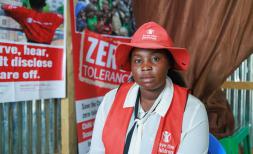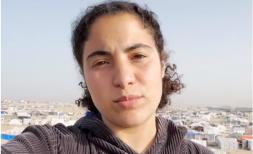Two years on and still waiting for justice - Why we cannot forget Rohingya children

13-year-old *Fatima is aware of the importance of school. She fled violence in Myanmar two years ago with nothing. She now lives in the world's biggest refugee camp with her parents, two sisters and grandfather. She has faced difficulties most children her age never will. She wants to be a teacher, but not just any teacher. She wants to teach girls because when girls are educated, they teach other girls.
*Fatima wants to have a future, just as hundreds of thousands Rohingya children who had to leave their homes. Two years into the crisis, however, they still live in squalid conditions. They have little hope, and those who are responsible for the atrocities have yet to face justice. It is time for the world to make sure that Rohingya children get justice for what they have suffered. This would protect them (and other children) from this happening again. It would give them the future they want.
In August 2017 over half a million Rohingya children were forced from their homes. It was the latest large-scale displacement of people since the Rwandan genocide in 1994.
Rohingya children have told us they witnessed rape, torture and killing. Some were raped and tortured themselves; many saw friends and family killed before their eyes. All they could do was run while their homes burnt.
They made their way across the border from Myanmar to Bangladesh, taking very little with them. In a remarkable act of solidarity, the people of Bangladesh gave them sanctuary and a sense of security they had lacked in Myanmar. The world came together to support the people in Bangladesh: it made sure that child refugees and their carers had somewhere to live and the opportunity to exercise their basic rights.
Because of this mobilisation, the tragedy of a forced exile did not lead to a secondary humanitarian disaster. A large area of jungle in Cox’s Bazar was cleared, makeshift shelters were erected, children were fed and outbreaks of disease were controlled. Although a major health emergency was averted, almost one million refugees continue to suffer.
Save the Children has been working in Cox’s Bazar since 2012 providing support to the most vulnerable people, both refugee and Bangladeshi children, in health, nutrition, hygiene, education and – perhaps above all – child protection. To date we have reached more than 400,000 children with our life-saving interventions.
But life for Rohingya refugee children like *Fatima remains bleak. She wants to learn but has no options when it comes to secondary or tertiary education. By only providing a rudimentary primary-level education in the camps, we are failing Rohingya refugee children, robbing them of the chance to serve their communities and the world at large. It’s not acceptable.
The shelters children live in are temporary, made of bamboo and plastic sheeting. They wouldn’t survive a strong wind, let alone a cyclone. One in ten children is still malnourished. Fears of trafficking, drugs and violent crime in the camps make children feel unsafe. Simple tasks like fetching water or going to the latrine after dark can be dangerous as children navigate through the poorly lit camps with little in the way of security. This is not acceptable either.
It’s not just Rohingya refugee children who need our help. The Bangladeshi children in the communities who welcomed the Rohingya two years ago have also had their lives turned upside down. A quiet, rural network of villages and small market towns has had to deal with the arrival of a million people. Homes and villages are now more susceptible to flooding and landslides because of the degradation of the surrounding forest. Healthcare services that were already at full capacity are overloaded. Resentment is increasing. Children from the host community are uncertain about their futures too.
Yet two years on we are no closer to a solution, no way out for the more than 500,000 children living in the camps in Cox’s Bazar. The prospect of a safe, voluntary and dignified return to Myanmar is remote. No third country is coming forward to offer resettlement. There is no prospect of a significant, settled relocation within Bangladesh.
The cliché – sadly often associated with refugees – is starting to be heard that the Rohingya children are a lost generation. But they are not lost. The world knows where they are. They need support now to ensure they can learn, that they are safe, they are healthy and they can have justice. They must not be forgotten.
The Government and people of Bangladesh have done a great global good in sheltering the Rohingya population the last two years. They need continued support from across the world.
But the long-term solution lies in Myanmar.
Conditions must be created to support the Rohingya’s safe, voluntary return to Myanmar, where the Government must fulfil one of the most basic responsibilities of any government – to guarantee the same level of safety and humanity for all people in the country. And those who are responsible for the crimes against the Rohingya must be held accountable for what they have done.
The Rohingya must be granted citizenship of the country where they were born, and where they grew up. In accordance with the UN Convention on the Rights of the Child, all children have the right to a nationality. This right is clear and unambiguous. The Government of Myanmar must cease the issuance of meaningless documents that guarantee no rights, and move immediately to grant citizenship to the Rohingya.
We owe it to *Fatima to give her a chance in life, to support her in realising her dreams; and for her not to remain a victim to a conflict in which she had no part.
*name changed
*Fatima (13) is a Rohingya refugee girl who benefits from attending one of Save the Children’s Child Friendly Spaces in the Rohingya refugee camps in Cox’s Bazar, Bangladesh. She is one of 50,000 children who is part of Save the Children’s child protection program and attends a Child Friendly Space, allowing her a safe space to play, recover and be a child again. As part of a photo project, *Fatima drew her emotions and fears on a polaroid picture of herself.







